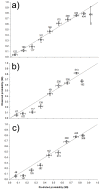Past, present and future distributions of an Iberian Endemic, Lepus granatensis: ecological and evolutionary clues from species distribution models
- PMID: 23272115
- PMCID: PMC3521729
- DOI: 10.1371/journal.pone.0051529
Past, present and future distributions of an Iberian Endemic, Lepus granatensis: ecological and evolutionary clues from species distribution models
Abstract
The application of species distribution models (SDMs) in ecology and conservation biology is increasing and assuming an important role, mainly because they can be used to hindcast past and predict current and future species distributions. However, the accuracy of SDMs depends on the quality of the data and on appropriate theoretical frameworks. In this study, comprehensive data on the current distribution of the Iberian hare (Lepus granatensis) were used to i) determine the species' ecogeographical constraints, ii) hindcast a climatic model for the last glacial maximum (LGM), relating it to inferences derived from molecular studies, and iii) calibrate a model to assess the species future distribution trends (up to 2080). Our results showed that the climatic factor (in its pure effect and when it is combined with the land-cover factor) is the most important descriptor of the current distribution of the Iberian hare. In addition, the model's output was a reliable index of the local probability of species occurrence, which is a valuable tool to guide species management decisions and conservation planning. Climatic potential obtained for the LGM was combined with molecular data and the results suggest that several glacial refugia may have existed for the species within the major Iberian refugium. Finally, a high probability of occurrence of the Iberian hare in the current species range and a northward expansion were predicted for future. Given its current environmental envelope and evolutionary history, we discuss the macroecology of the Iberian hare and its sensitivity to climate change.
Conflict of interest statement
Figures



References
-
- Franklin J (2009) Mapping species distributions. Spatial inference and prediction. Cambridge: Cambridge University Press. 320 p.
-
- Levin SA (1992) The problem of pattern and scale in ecology. Ecology 73: 1943–1967.
-
- Soberón JM (2010) Niche and area of distribution modeling: a population ecology perspective. Ecography 33: 159–167.
-
- Guisan A, Thuiller W (2005) Predicting species distribution: offering more than simple habitat models. Ecol Lett 8: 993–1009. - PubMed
-
- Guisan A, Zimmermann NE (2000) Predictive habitat distribution models in ecology. Ecol Model 135: 147–186.
Publication types
MeSH terms
Substances
LinkOut - more resources
Full Text Sources
Miscellaneous

